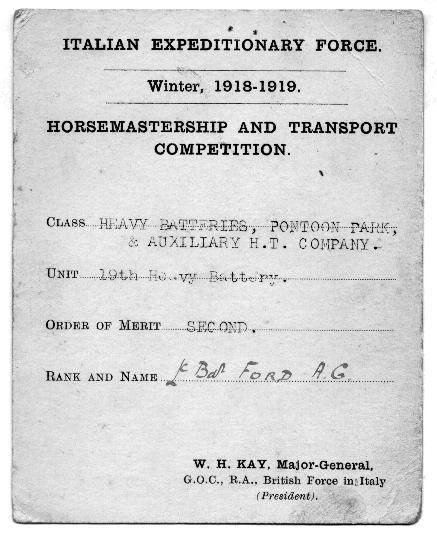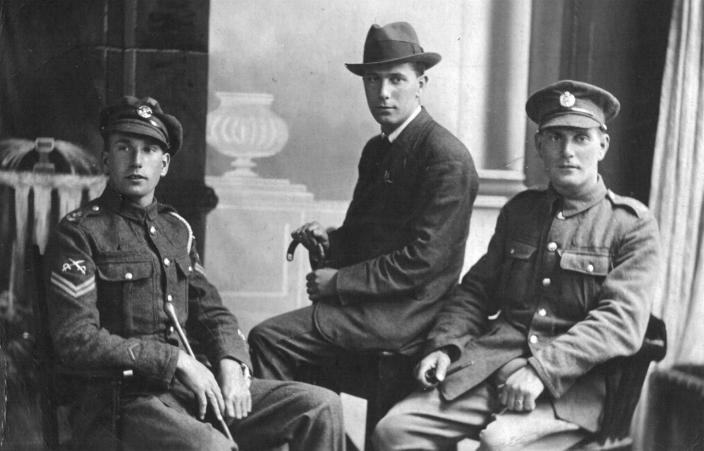|
Winterbourne Family History Online... |
|
|
Sidney Charles Ford was born about 1860. He came to live at Newlands Cottage, Frenchay and worked as a Coachman, possibly for the Tanner Family. We are indebted to Terry Ford, son of Arthur Graham, for permission to use these photographs and stories. |
He married Emily Browning and they had five children... Sidney Alexander born c1886, Arthur Graham 1888, Frances Mary c1890, Thomas Charles 1894, and Reginald Harry 1898. They all grew up in the cottage. |
|
In February 1918, Frances Mary Ford, munitions worker, married Lance Corporal William Herbert Lovell of Downend. He was on active duty serving with the Army Ordnance Corps. In their wedding photograph, Francesí father, Sidney, was not there because he had died in May of the previous year, at age 57. His wife Emily, seen sitting to the brideís left and wearing a black hat, survived him by many years and died in 1951 at the grand age of 85 years. She had always claimed to be a relative of the poet, Robert Browning, and that she had sat on his lap, as a child, when he visited the family. She once remarked that he appeared to be rather shabby. Also in the wedding picture, on the right in uniform, is Arthur Ford with Maud Trolley to his left in the white hat and Millie Lovell, sister of William, on his right. The gent far left is Alec Brown, an entrepreneur who later became Manager of Bath City Football Club for a time. The gent in the top hat is the groomís father, Charles Lovell, Postal Civil Servant. The photograph was taken outside of Newlands Cottage, Frenchay - since demolished. |
|
|
|
Arthur Graham Ford
enlisted in the Royal Garrison
Artillery as a Gunner during the first month of The Great War. He
served at the front and at Passchendaele, but when the Austrians broke
through the Italian lines he was transferred to Italy. He said later it
was like moving from Hell to Heaven.
During the Second World War he took over the White Lion pub in Frenchay and ran it until 1958. His son, Terry, well remembers the Americans from the Frenchay Hospital sampling the local brews. He also recalls that when his father joined the 12th (Home Guard) Battalion Goucester Regt as a private, Terry was Corporal over him. Gives a new twist to "Dadís Army", doesnít it? |
|
Arthur is seen here playing for the Frenchay Cricket Club 2nd XI in 1907, playing for the Frenchay Football team in 1910 and then Vice-Captain for the Frenchay 1st XI in 1920. |



|
|
|
Lance Bombadier
Arthur Graham Ford
was a skilled horseman, and had his own horse during the Great
War.
This document reads... Class: Heavy Batteries, Pontoon Park, & Auxiliary HT Company. Unit: 19th Heavy Battery. Order of Merit: Second Rank & Name: Lc Bdr Ford AG. |
|
This historic piece of paper, used by Bombardier AG Ford and dated 29.10.15, survived the trench warfare and reads: Please pass bearer through to Artillery Observation Post at Barles-au-Bois. Signature appears to read E Caldecott, Capt.
Arthur was awarded his 1914/15 Star in 1920. |

|
|
|
|
|
The three brothers of Arthur; photograph taken during the Great War. Left: Reginald Harry Ford, training in the Training Reserve Battalion. Later, in the Second World War, he served as a Sergeant and became an instructor at an Officer Cadet Training Corps. He was wounded in an accident with a hand grenade. He was with 238 HAA Battery, 76th Regt Royal Artillery, on the gun known as Purdown Percy and the gun at Hambrook Brickfields. He died during the war at age 39 and was buried at Westerleigh. Reg is remembered as a very good batsman for Frenchay. Centre: Thomas Charles Ford, Machine Gun Corps, Wilts Regt. Right: Sidney Alexander Ford, born about 1886. He served in Mesopotamia during the Great War. He was the only son not to marry and was buried next to his parents in Frenchay Graveyard in 1948. |
|



